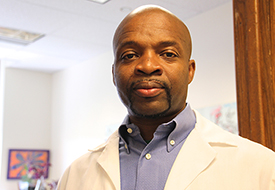For the Love of Worms
De’Broski Herbert’s WALS Lecture

PHOTO BY: GAYLE JOSEPH, UPENN
De’Broski Herbert, an associate professor of immunology at the University of Pennsylvania School of Veterinary Medicine (Philadelphia), regaled a WALS audience with stories of his research on worms.
Growing up in Mississippi, De’Broski Herbert was warned by his great-grandmother never to walk barefoot outside. It wasn’t until a parasitology class during his sophomore year at Xavier University of Louisiana (New Orleans) that Herbert understood the phenomena behind his great-grandmother’s homespun wisdom: intestinal parasites, specifically hookworms (a type of nematode). Such worms became infamous after they were discovered to cause pernicious anemia and stunted growth among schoolchildren in the southern United States at the turn of the 20th century. They were later targeted for eradication by the Rockefeller Foundation and other programs.
Hookworm larvae live in fecal-contaminated soil and can penetrate the feet of anyone who happens to walk barefoot through the area. The larvae migrate from the skin through blood vessels to the lungs; travel to the trachea, where they are swallowed; make their way to the intestine, where they mature into adult worms; and mate. The females can lay up to 30,000 eggs a day. The eggs leave the body through the feces, and the cycle continues.
It was that sophomore-year parasitology class that hooked Herbert on worms. He then spent two summers at the University of California, San Francisco (UCSF), doing undergraduate research on the blood-infecting parasite Babesia microti (which causes malaria-like symptoms), and he became fascinated with biomedical research.
He credits his passion for science to the freedom and novelty of discovery, adopting the motto “If the excitement of a discovery keeps you awake at night, the career possibilities are endless.”
Herbert followed his fascination for nematodes (which pose a global health problem) and immunology to David Abraham’s lab at Thomas Jefferson University (Philadelphia) where he got his Ph.D. in immunology in 2000, and then to Frank Brombacher’s lab at the University of Cape Town, South Africa, for his postdoctoral training. He went on to hold faculty positions at the University of Cincinnati (Cincinnati), the Cincinnati Children’s Research Foundation (Cincinnati), and UCSF. In 2016, he became an associate professor of immunology at the University of Pennsylvania School of Veterinary Medicine (Philadelphia).
Through the study of parasitic worms, his lab has made important contributions toward understanding the mechanisms controlling the development of alternatively activated macrophages and type 2 inflammation in the respiratory and gastrointestinal tracts.
Herbert shared his enthusiasm for nematodes with an NIH audience on June 21, 2018, when he delivered a Wednesday Afternoon Lecture (WALS) entitled “LINGO Proteins: A New Language for the Mucosal Barrier.” In that WALS talk, he told the story of how his lab used a nematode model to discover the LINGO-2 protein (short for leucine-rich repeat and immunoglobin-like domain-containing interacting protein–2).
It turns out that a LINGO-2 deficiency in a host results in improved immunity against the nematode Nippostrongylus brasiliensis, a natural worm pathogen that infects rats.
The discovery ties into Herbert’s recent work on trefoil factors (TFFs), a family of small, abundant, secreted proteins that protect the mucous epithelia in the gastrointestinal tract. TFFs promote tissue repair, for example, in Crohn disease and colitis. Called trefoil factors because of their distinctive three disulfide-bridge loops, these small signaling proteins are produced by goblet cells (secretory cells within the epithelial linings of organs mainly in the intestinal and respiratory tracts) within hours of injury and constitutively reside at epithelium locations where they can influence epithelial resistance, gastric protection, angiogenesis, and inhibit apoptosis. It was through an interest in trefoils that his lab started to study LINGO-2.
The Herbert lab found LINGO-2 by using LRC-triCEPS (short for ligand-receptor capture trifunctional-chemo-proteomics-reagent) technology, in which bait proteins are paired with the special triCEPS compound, which consists of three domains: one to bind the ligand, one to cross-link with the target, and one to purify the captured receptor-triCEPS hybrid for mass spectrometry identification.
After a worm infection, a deficiency in LINGO-2 enhances the activation of the epidermal-growth-factor receptor, promoting the clearing of gastrointestinal nematode infections and repair of the gastrointestinal tract. Clinical applications include the possibility of making LINGO-2 blockers to increase immunity to nematodes.
Working with nematodes has unique challenges, though. For example, the tiny worms move surprisingly quickly, making microscopy difficult, and gene deletions—the tried-and-true method for geneticists—in this particular worm species’ are not inherited in the next generation. The Herbert lab has overcome this problem recently by using worms of the asexual Strongyloides genus and by microinjection of the gonadal tissue to create a novel worm line with offspring that are genetically identical to the mutated parent. Through manipulating the genomes of both host and hookworm, the Herbert lab hopes to revitalize the field of parasite immunology.
For Herbert, these challenges are part of the journey to discovery, and he makes a point of having fun with all steps along the way. For example, he names his transgenic worm lines after Marvel characters. He has a “Hulk” green fluorescent protein (GFP)-labeled worm line and a “Scarlet Witch” GFP-secreting and red fluorescent protein–expressing worm line. He hopes to add more to his “marvelous” collection. Always enthusiastic about nematodes, Herbert hopes that through spreading his passion there will be “more people in the world who love worms as much as I do!”
To watch a videocast of Herbert’s WALS lecture, presented on June 21, 2018 (HHS and NIH only), go to https://videocast.nih.gov/launch.asp?23976.
This page was last updated on Wednesday, April 6, 2022
